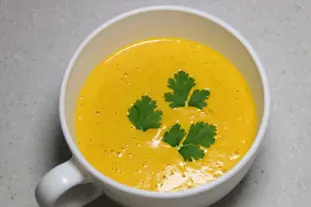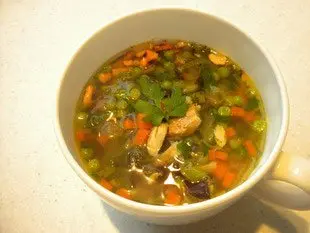This site uses only a few technical cookies necessary for its operation. By continuing to browse, you accept their use.
To find out more...
To find out more...
Soup vs. potage

It's true that we're finally coming out of winter as I write these lines, and that we'll all be making, no doubt, a little less soup and potages, but even if it's out of season, it really is a simple and delicious dish, which is one of the always easy answers to "What's for dinner this (Sunday) evening?".
Speaking of soups and potages, even if they're very similar, do you know the difference?
Speaking of soups and potages, even if they're very similar, do you know the difference?
11 K
Keywords for this post:SoupPotageDifferenceCookingVegetablesBrothWaterLast modified on: April 9th 2022
Soup vs. potage
Soups

Basically, it's water and vegetables cut into small pieces, seasoned and cooked until the vegetables are well done, to obtain a soup.
Of course, the basic recipe can be enriched by replacing the water with broth or milk, for example, or by adding various small ingredients: leftover cooked meat, legumes, croutons, etc. etc. The only limit is your imagination, and what you have in your cupboards or fridge.
Potages

Basically, it always starts out as a soup: water + vegetables that you cook, but then there's the difference: you blend it or put it through a food mill, and you get a soup.
A soup that can also be enriched and improved by adding all kinds of ingredients: Cream, grated cheese, a little cornflour to thicken, etc.
The term "potage" comes from the 17th century, in the sense of "vegetables cooked in a pot", and then gave rise to "potager", a place where vegetables are grown for soup.
As you can see, it's more a question of texture: soup has chunks, while potage is smoother.
Having said that, this boundary is rather blurred, as the 2 words are used for a whole host of very different dishes on restaurant menus, for example, and thus fall outside the usual domain: starter or single dish, hot and savory.
Desserts include fruit soups, for example, which are often a fruit juice or a custard, or both, in which pieces of fruit are placed.
In short, with the imagination of chefs, a soup is just about any dish, made up of a liquid part and a solid part in small pieces, strawberry soup for example.

Other words
In addition to soup and potage, there are other related words, a little outdated nowadays, to designate more specific kinds of soup:
Consommé: In principle, this is a soup in which the water is replaced by a broth, usually beef, which is fairly full-bodied and sometimes with wine added. In ancient times, it was a popular starter at festive meals.
Velouté: This is a soup generously enriched with cream, and sometimes bound with a little cornflour, and very carefully blended or even sieved, all to obtain something very smooth and creamy.
Bisque: This is a soup based on cream and shellfish (lobster, shrimp, etc.).
All these appetizing variations should not blind us to the fact that there's almost nothing simpler to make than a soup at home: water, a few vegetables, salt/pepper and you're done!
And let's not forget that soup has been the mainstay of our meals, if not the meal itself, for centuries (just look at the number of expressions with "soup" in them: soupe au lait, soupe à la grimace, cracher dans la soupe, ...).
It's a dish that's probably as old as humanity itself, and can be found in every culture, in every country. A good thing it has in common with bread.
To sum up: soup is mainly vegetables cooked in water, so there are chunks, whereas potage is a soup that has been blended or put through a food mill.
Lasts posts
Getting out of the fridge early
Very often when you're cooking, you need to take food or preparations out of the fridge, to use them in the recipe in progress. There's nothing tricky about this: you just take them out of the fridge and use them, usually immediately, in the recipe. But is this really a good method?November 24th 20258555
Who's making the croissants?
When you look at a bakery from the outside, you naturally think that in the bakery, the bakers make the bread, and in the laboratory, the pastry chefs make the cakes. It's very often like that, with each of these professions having quite different ways of working, but sometimes there's also one...November 23th 2025771
Oven height
When we put a dish or cake in the oven, we naturally tend to put it on the middle shelf, and that's what we usually do. But in some cases, this position and height can be a little tricky, so let's find out why.October 8th 20252,3255
The importance of sieving
In recipes that use a fine powder (flour, powdered sugar, etc.), you'll often see the advice to sift before using it. To sift is to pass the powder in question through a sieve (a very fine strainer) before incorporating it into your recipe. It's often advice, but is it really useful?September 3rd 20257,2843
The grease spray
As soon as you have something in a recipe that sticks to the mold, the question always arises as to how difficult it is to remove from the mold. There's nothing more frustrating than breaking your cake when unmolding it, because part of it has stuck in the mold. The classic way to avoid this is...August 26th 20256,8145
Other pages you may also like
Candied fruits: don't get ripped off
Do you like candied fruit? You might like to nibble a handful or add it to a recipe, like a classic fruit cake or delicious Italian specialities like panettone or sicilian epiphany pie.June 21th 201767 K 24.2
The window-pane test in bread-making
The home bread-makers often ask themselves “Have I kneaded my dough long enough?” . A good question, as dough that is insufficiently kneaded will not rise properly or will fall flat when the top is slashed, which is very frustrating. To know when the dough is ready, one can rely on the length...June 16th 202196 K 23.9
What can I use for blind baking a pastry case?
When it comes to home-made desserts, tarts are always popular. They can be divided into two basic types: those cooked with their filling, such as an apricot and almond cream tart, and those where the filling is added after baking the pastry case, such as a strawberry tart or chocolate tart. For...May 2nd 2017112 K4.5
Cleaning endives
If you buy your endives elsewhere than in supermarkets, and in this case the best is of course from a market gardener, he or she is the one who planted and harvested them, in this case you will have endives full of earth or sand, depending on where they were grown, which is normal and reassuring, we...March 24th 202026 K4.6
Unmoulding cakes while hot
When you make a cake, pound cake or whatever (what bakers call a "travel cake" because it's easy to carry around) you've most likely made a batter, either by hand or in a food processor, which you then pour into a buttered pan. It's a classic, and I've already talked to you about 2 or 3 tips on...February 6th 202138 K4.6
Post a comment or question
Follow this page
If you are interested in this page, you can "follow" it, by entering your email address here. You will then receive a notification immediately each time the page is modified or a new comment is added. Please note that you will need to confirm this following.
Note: We'll never share your e-mail address with anyone else.
Alternatively: you can subscribe to the mailing list of cooling-ez.com , you will receive a e-mail for each new recipe published on the site.









